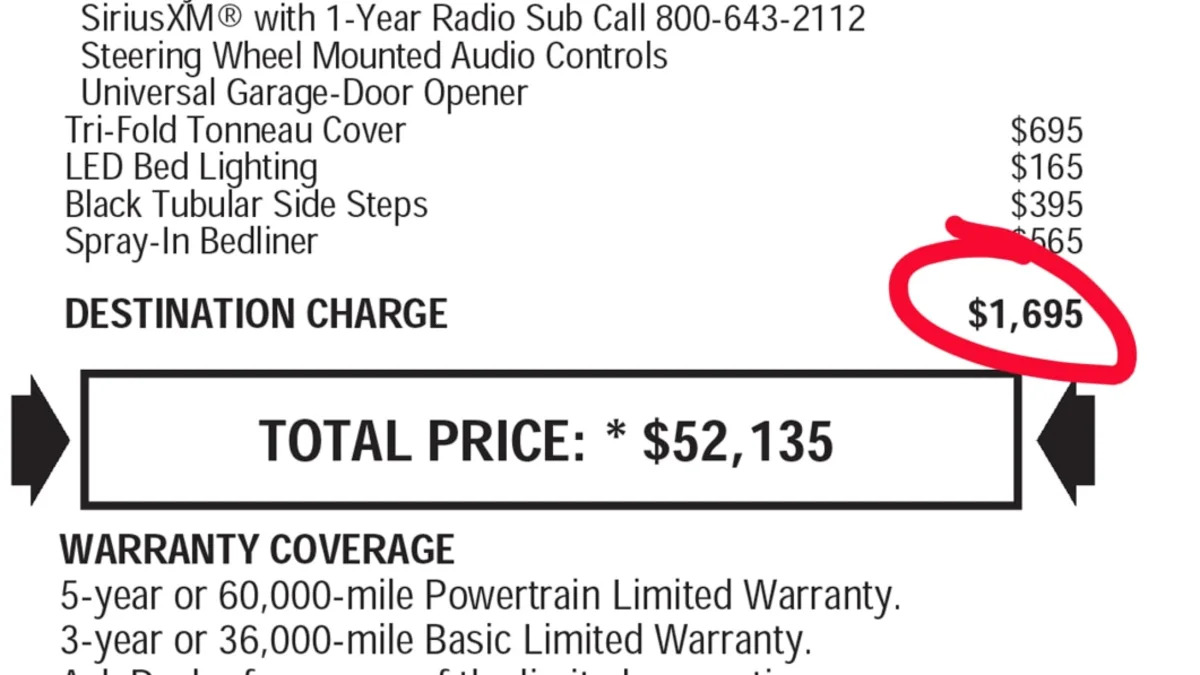Looking at the line-item breakdown of what it actually costs to buy a car can sometimes be stressful. Cars are already expensive, and then there are hundreds of dollars in individual fees tacked on. Let's cover one that seems suspiciously simple: the destination charge. So, first of all, what is a destination charge?
- The 10 cars with the most expensive destination charges
- The 10 cars with the least expensive destination charges
This is part of our Car Buyer's Glossary series breaking down all the terms you need to know if you're buying a new or used car from a dealership.
What does the destination charge cover?
Also known as the destination fee, the destination charge theoretically covers the cost it takes to get a car from the factory to the dealership. Some dealers and automakers have other terms for it, whether it's "freight," "handling" or "DFC," but it should be the only fee you pay to cover the costs associated with getting your car to the dealership where you bought it. It's usually a flat fee, meaning it doesn't vary by region. It's "equalized" – that is to say, the average cost to ship cars all over the country. If your dealer is right next to the factory that built the car, too bad – you have to pay, too, so folks a couple thousand miles away don't have a massive charge.
Is the destination charge regulated by the government?
The way in which the destination charge is calculated (that equalization thing mentioned above) is government-mandated, as is the need to make it an individual line item on the Monroney sheet – that window sticker with the MSRP and all the other options fees broken out.
Do cars transported from far away have higher destination charges?
Logically you'd think so, but that's not the case. Ram trucks built in America can have destination charges of $1,995, whereas a Hyundai Palisade built in Korea costs just $1,335 to ship. While there are myriad reasons for this, in short, the destination charge accounts for its shipment within the U.S., so the international transportation fees are simply baked into the cost of the vehicle itself, which is subject to market forces.
Can you negotiate the destination charge?
You can't. It's a fixed cost, which is why Autoblog and a few other car publications add the destination charge to all new car prices. You have to pay it, so why keep it separate? There are plenty of other things to negotiate over, like documentation fees. But this fixed cost, which is the same for anybody buying the same vehicle anywhere in the country, is not a negotiable fee.
Are destination charges getting more expensive?
For the most part, yes. As we documented back in May 2021, destination charges have skyrocketed in recent years. Although destination charge calculations are technically regulated by the government, the factors contributing to those calculations of each manufacturer are not clear. It's hard not to look at these increases with a skeptical eye when some car companies are jacking up their destination charges while others are keeping them steady or increasingly by a substantially smaller margin.
What about other fees described as transportation or delivery charges?
Here's the wrinkle: sometimes there's another delivery-type charge added afterwards, in addition to the standard destination charge. This is kind of a sneaky move unscrupulous dealers might try to slip in. Basically, it's an extra and unnecessary charge. The dealer might try to tell you that it's the cost of getting the vehicle to this specific lot, being particularly far away from the factory, or something like that – but since you now know about "equalized" destination charges, you can tell the dealer you're only paying the charges listed on the window sticker. End of story.
- Related: What is MSRP?
So, to summarize: you must pay a destination charge when you buy a new car, but you do not have to pay it twice. Make sure you ask for all of the individual fees the dealer is asking you to pay are detailed to your satisfaction, and watch out for duplicated fees with slightly different names. This practice isn't common, but it's better to be safe than to pay a few hundred bucks you didn't need to.


Sign in to post
Please sign in to leave a comment.
Continue